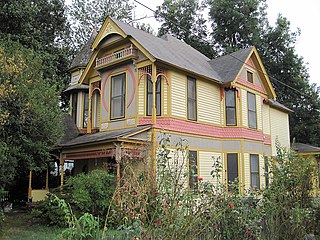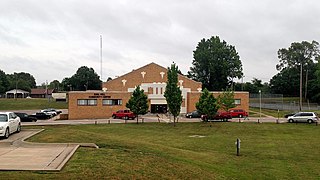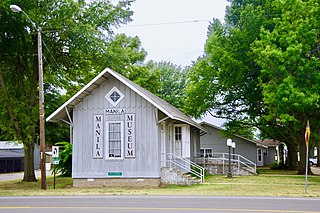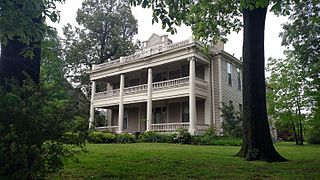
Craighead County is a county located in the U.S. state of Arkansas. As of the 2020 census, the population was 111,231. The county has two county seats — Jonesboro and Lake City. Craighead County is Arkansas's 58th county, formed on February 19, 1859, and named for state Senator Thomas Craighead. It is one of several dry counties within the state of Arkansas, in which the sale of alcoholic beverages is largely prohibited.

Jonesboro is a city located on Crowley's Ridge in the northeastern corner of the U.S. State of Arkansas. Jonesboro is one of two county seats of Craighead County. According to the 2020 Census, the city had a population of 78,576 and is the fifth-largest city in Arkansas. In 2020, the Jonesboro metropolitan area had a population of 133,860 and a population of 179,932 in the Jonesboro-Paragould Combined Statistical Area.

Highway 463 is a north–south state highway in northeast Arkansas. The route of 20.59 miles (33.14 km) runs from Highway 14 very near I-555 at Payneway north to I-555/US 63B in Jonesboro. The route is a redesignation of former U.S. Route 63, which has since been rerouted onto US 49.
Berger House may refer to:

Highway 141 is designation for two north–south state highways in Northeast Arkansas. The longer segment was created in 1931 and extended throughout the mid-20th century to the current alignment connecting Jonesboro and points north. The Jonesboro segment was a former city street added to the state highway system in 1973. Both are maintained by the Arkansas Department of Transportation.

Twelve special routes of U.S. Route 63 currently exist. Arkansas and Missouri each contain five, with two in Iowa. There are also five former routings that have been removed from the system.

Several special routes of U.S. Route 49 exist. In order from south to north they are as follows.
Three auxiliary routes of Arkansas Highway 18 exist in northeast Arkansas.

The Mercantile Bank Building is a historic bank building at 249 South Main Street in Jonesboro, Arkansas. The brick building was built in 1890 for Craighead County Bank. The bank used the building until 1894. It was then used as a clothing store and for offices afterwards until 1901 when it was occupied by Jonesboro Savings & Trust,. The architectural firm of Hoggson Brothers conducted a 1919 update and remodel of the building. Jonesboro bank closed in 1931 and, after fundraising efforts to open a new bank in the town, Mercantile Bank opened in the building in 1932. Mercantile moved its bank in 1969 and Crowley's Ridge Development Council used the building until 2004.

The Bell House is a historic house at 303 West Cherry Street in Jonesboro, Arkansas. It is a two-story wood-frame structure, built in 1895 by J. V. Bell, owner of one of Jonesboro's first bookstores. The house is an elaborately-decorated Queen Anne Victorian, with an asymmetrical arrangement of projecting bays, gables, and porches. The front porch has a delicate spindle-work frieze, and is supported by turned columns. Different types of cut shingles give variety to the wall surfaces.

The Berger House is a historic house at 1120 South Main Street in Jonesboro, Arkansas.
The Berger-Graham House is a historic house at 1327 South Main Street in Jonesboro, Arkansas. Situated on one of the highest points in the city, this is an imposing brick structure with Classical Revival and Richardsonian Romanesque characteristics. Its brick walls are eighteen inches think, supporting a hip roof with cross gables and dormers. The main entrance is recessed under a large round arch that is the focal point of the front elevation. The house was built in 1904 by Marcus Berger, a wealthy businessman, as a wedding present for his son Joseph. In 1909 it was purchased by W. H. Graham, a wholesale cotton broker. After financial reverses in the Great Depression, Graham converted the property into a boarding house.

The Community Center No. 1 is a historic government building at 1212 South Church Street in Jonesboro, Arkansas, USA. It is a single-story building, faced in buff brick, with a stylish Art Deco entrance area consisting of towers and projections made of smooth white concrete. The entrance is flanked by large flat-roof sections which house recreational facilities, while the center section has a low-pitch gable roof. The community center was designed by Elmer A. Stuck, and built in 1936 with funding from the Public Works Administration. The center has undergone several name changes, and is now known as the Earl Bell Community Center, after the Olympic pole vaulter and Jonesboro native.

The Jonesboro, Lake City & Eastern Railroad Depot is a historic former railroad station in Manila, Arkansas. It is a modest single-story wood-frame structure with a gable roof, standing at the northwest corner of South Dewey and Baltimore Streets. The station was built in 1910 by the Jonesboro, Lake City and Eastern Railroad, and is a well-preserved example of a wood-frame board-and-batten station of the period. It is now owned by the city.

The Craighead County Courthouse is located at 511 Main Street, in the center of Jonesboro, Arkansas, the county seat of Craighead County. It is a two-story brick structure with limestone trim, built in 1934, and is the city's only significant example of Art Deco architecture. The building has a stepped appearance, with a large central block that has an oversized second story, and is flanked by smaller two-story wings, from which single-story sections project to the front and back. Vertical panels of fluted limestone accentuate corner projections from the main block, a motif repeated near the roof line of that block. The main entrance is recessed in an opening flanked by similarly fluted panels. The courthouse is the fifth of the county to stand on the site. Near the entrance to the courthouse stands a copy of John Paulding's World War I memorial, Over the Top, placed in 1920, and often confused with E. M. Viquesney's "Spirit of the American Doughboy".

The Frierson House is a historic house at 1112 South Main Street in Jonesboro, Arkansas. It is a two-story wood-frame structure, with a hip roof pierced by gabled dormers. The main facade is covered by a two-story porch with Ionic columns, with a single-story porch on the side with Doric columns. The main entrance is flanked by sidelight windows and topped by a multilight transom, and is set in a recessed paneled entry framed by pilasters. Its construction date is uncertain, but is placed between 1870 and 1910 based on architectural evidence. It is a well-preserved example of a post-Civil War "town house".

The West Washington Avenue Historic District of Jonesboro, Arkansas, encompasses a concentrated grouping of residential buildings built between 1890 and 1930. It represents the best-preserved section of the city's first planned subdivision, including thirteen historic properties on a 1-1/2 block stretch of West Washington Avenue extending east from Mclure Street and beyond Flint Street. Stylistically these houses represent a cross-section of architecture popular in the period, including Queen Anne Victorians and Tudor Revival structures. Most of the houses are built of brick, and there is one church.
The C.A. Stuck and Sons Lumber Mill is a historic industrial complex at 215 Union Street in Jonesboro, Arkansas. It consists of four buildings: an office building, a lumber mill, and two storage sheds. All four buildings are brick structures built c. 1890, although the office building was enlarged and given a new facade in 1905. The Stuck mill, which was established in 1889, is one of the oldest properties associated with the early efforts to deforest Craighead County. C.A. Stuck was an Illinois-based furniture builder who moved to Jonesboro to facilitate the production of lumber for his products.
The Home Ice Company was a historic industrial building at 700 Cate Avenue in Jonesboro, Arkansas. A two-story wood-frame building was erected here in 1907 to house a wagon factory, which in 1920 was enlarged with a Mission Revival facade designed by Henry Lesmeister. From 1929 until 2013 the building was used to house an ice-making operation, and was a rare surviving example of an early ice manufactory.

The Jonesboro U.S. Post Office and Courthouse is a former federal building located at 524 South Church Street, in downtown Jonesboro, Arkansas. It is a three-story masonry structure, built out of brick and limestone. The ground floor is visually presented as a basement level clad in red brick, while the upper levels are finished in stucco with brick trim. Although the building lacks rounded-arch openings normally found in the Renaissance Revival, it is laid out along lines typical of that style, with the courtrooms on the second floor in the piano nobile style. The building was built as a courthouse and post office in 1911–13 to a design by James Knox Taylor, the Supervising Architect of the United States Treasury. It was used as a federal courthouse until 1977, and has seen a variety of commercial uses since then.

















